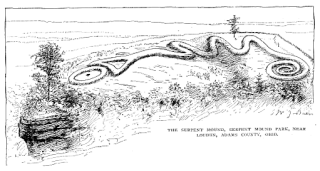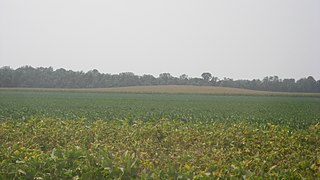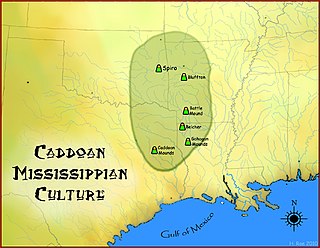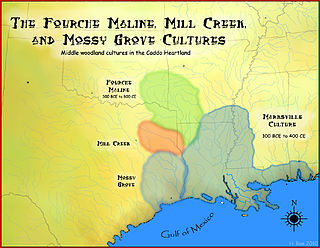
The Hopewell tradition describes the common aspects of an ancient pre-Columbian Native American civilization that flourished in settlements along rivers in the northeastern and midwestern Eastern Woodlands from 100 BCE to 500 CE, in the Middle Woodland period. The Hopewell tradition was not a single culture or society, but a widely dispersed set of populations connected by a common network of trade routes. This is known as the Hopewell exchange system.

A number of pre-Columbian cultures are collectively termed "Mound Builders". The term does not refer to a specific people or archaeological culture, but refers to the characteristic mound earthworks erected for an extended period of more than 5,000 years. The "Mound Builder" cultures span the period of roughly 3500 BCE to the 16th century CE, including the Archaic period, Woodland period, and Mississippian period. Geographically, the cultures were present in the region of the Great Lakes, the Ohio River Valley, and the Mississippi River valley and its tributary waters.

The Adena culture was a Pre-Columbian Native American culture that existed from 500 BCE to 100 CE, in a time known as the Early Woodland period. The Adena culture refers to what were probably a number of related Native American societies sharing a burial complex and ceremonial system. The Adena culture was centered on the location of the modern state of Ohio, but also extended into contiguous areas of northern Kentucky, eastern Indiana, West Virginia, and parts of extreme western Pennsylvania.

In the classification of archaeological cultures of North America, the Woodland period of North American pre-Columbian cultures spanned a period from roughly 1000 BCE to European contact in the eastern part of North America, with some archaeologists distinguishing the Mississippian period, from 1000 CE to European contact as a separate period. The term "Woodland Period" was introduced in the 1930s as a generic term for prehistoric sites falling between the Archaic hunter-gatherers and the agriculturalist Mississippian cultures. The Eastern Woodlands cultural region covers what is now eastern Canada south of the Subarctic region, the Eastern United States, along to the Gulf of Mexico.

Hopewell pottery is the ceramic tradition of the various local cultures involved in the Hopewell tradition and are found as artifacts in archeological sites in the American Midwest and Southeast. The Hopewell were located around the Mississippi and Illinois Rivers during the Middle Woodland Period, and the Hopewell Interaction Sphere spanned from the Gulf of Mexico to Ontario, Canada.

The Swift Creek culture was a Middle Woodland period archaeological culture in the Southeastern Woodlands of North America, dating to around 100-800 CE. It occupied the areas now part of Georgia, Alabama, Florida, South Carolina, and Tennessee. In Florida, Swift Creek ceremonial practices and burial complexes are referred to technically as the Yent-Green Point complex. The Swift Creek culture was contemporaneous with and interacted with the Hopewell culture; Swift Creek is often described as "Hopewellian." The type site for the Swift Creek culture was the Swift Creek mound site, which was located in Bibb County, Georgia. The Leake Mounds are another significant Swift Creek Culture site in Georgia.

The Kincaid Mounds Historic Site c. 1050–1400 CE, is a Mississippian culture archaeological site located at the southern tip of present-day U.S. state of Illinois, along the Ohio River. Kincaid Mounds has been notable for both its significant role in native North American prehistory and for the central role the site has played in the development of modern archaeological techniques. The site had at least 11 substructure platform mounds, and 8 other monuments.

Albany Mounds State Historic Site, also known as Albany Mounds Site, is a historic site operated by the Illinois Historic Preservation Agency. It spans over 205 acres of land near the Mississippi river at the northwest edge of the state of Illinois in the United States. In 1974, the site was added to the National Register of Historic Places list. The historical site is under the provision of the Illinois Historic Preservation Agency, a governmental agency founded in 1985 for the maintaining of historical sites within the state. In the 1990s, the site underwent a restoration project that aimed to return its appearance to its original condition.

Leake Mounds (9BR2) is an important archaeological site in Bartow County, Georgia built and used by peoples of the Swift Creek Culture. The site is 2 miles (3.2 km) west of the well-known Etowah Mounds on the Etowah River. It predates that site by hundreds of years.
The Prehistory of West Virginia spans ancient times until the arrival of Europeans in the early 17th century. Hunters ventured into West Virginia's mountain valleys and made temporary camp villages since the Archaic period in the Americas. Many ancient human-made earthen mounds from various mound builder cultures survive, especially in the areas of Moundsville, South Charleston, and Romney. The artifacts uncovered in these areas give evidence of a village society with a tribal trade system culture that included limited cold worked copper. As of 2009, over 12,500 archaeological sites have been documented in West Virginia.

Prehistory of Ohio provides an overview of the activities that occurred prior to Ohio's recorded history. The ancient hunters, Paleo-Indians, descended from humans that crossed the Bering Strait. There is evidence of Paleo-Indians in Ohio, who were hunter-gatherers that ranged widely over land to hunt large game. For instance, mastodon bones were found at the Burning Tree Mastodon site that showed that it had been butchered. Clovis points have been found that indicate interaction with other groups and hunted large game. The Paleo Crossing Site and [[Nobles Pond Site Tools, like spear-throwers, were more sophisticated. Base camps were established for winter lodging. The Glacial Kame culture, a late Archaic group, traded for sea shell and copper with other groups and were used as a sign of prestige within the group, for respected healers and hunters. The objects were buried with their owners.

The Saugeen Complex was a Native American culture located around the southeast shores of Lake Huron and the Bruce Peninsula, around the London area, and possibly as far east as the Grand River. They were active in the period 200BCE to 500CE. There is archeological evidence that the Saugeen complex people of the Bruce Peninsula may have evolved into the Odawa people (Ottawa).

The Laurel Complex was a Native American culture in southern Quebec, southern and northwestern Ontario and east-central Manitoba in Canada and northern Michigan, northwestern Wisconsin and northern Minnesota in the United States. They were the first pottery using people of Ontario north of the Trent–Severn Waterway. The complex is named after the former unincorporated community of Laurel, Minnesota.

The Kansas City Hopewell were the farthest west regional variation of the Hopewell tradition of the Middle Woodland period. Sites were located in Kansas and Missouri around the mouth of the Kansas River where it enters the Missouri River. There are 30 recorded Kansas City Hopewell sites.

The Mann Site is a Crab Orchard culture site located off Indian Mound Road in Mount Vernon, Posey County, Indiana. It was placed on the National Historic Register on October 1, 1974. Exotic ceramics and other artifacts found at the site reflect contact with Ohio Hopewell people, in addition to more distant peoples in the Southeast of the Swift Creek culture of the Georgia Piedmont and Gulf Coastal Plain.

The Marksville culture was an archaeological culture in the lower Lower Mississippi valley, Yazoo valley, and Tensas valley areas of present-day Louisiana, Mississippi, Arkansas, and extended eastward along the Gulf Coast to the Mobile Bay area, from 100 BCE to 400 CE. This culture takes its name from the Marksville Prehistoric Indian Site in Avoyelles Parish, Louisiana. Marksville Culture was contemporaneous with the Hopewell cultures within present-day Ohio and Illinois. It evolved from the earlier Tchefuncte culture and into the Baytown and Troyville cultures, and later the Coles Creek and Plum Bayou cultures. It is considered ancestral to the historic Natchez and Taensa peoples.

The Caddoan Mississippian culture was a prehistoric Native American culture considered by archaeologists as a variant of the Mississippian culture. The Caddoan Mississippians covered a large territory, including what is now Eastern Oklahoma, Western Arkansas, Northeast Texas, and Northwest Louisiana of the United States.

The Fourche Maline culture was a Woodland Period Native American culture that existed from 300 BCE to 800 CE, in what are now defined as southeastern Oklahoma, southwestern Arkansas, northwestern Louisiana, and northeastern Texas. They are considered to be one of the main ancestral groups of the Caddoan Mississippian culture, along with the contemporaneous Mill Creek culture of eastern Texas. This culture was named for the Fourche Maline Creek, a tributary of the Poteau River. Their modern descendants are the Caddo Nation of Oklahoma.
Iroquoian peoples are Iroquoian speaking Indigenous people of the Northeastern Woodlands and Great lakes of North America whose territories stretched from southeastern and southern Ontario in Canada along the shores of Lake Huron and Georgian bay, Lake Erie and Lake Ontario to New York state, northern Ohio and Pennsylvania.


















